Organic Trace Mineral Source Enhances the Bioavailability, Health Status, and Gut Microbiota Community in White Shrimp (Penaeus vannamei)
Simple Summary
Abstract
1. Introduction
2. Materials and Methods
2.1. Ethics Statement
2.2. Experimental Diets
2.3. Feeding Trial
2.4. Sample Collection
2.5. Proximate Compositions of Feeds
2.6. Hematological Parameters and Enzyme Activities
2.7. RNA Extraction and qPCR
2.8. Trace Minerals Analysis
2.9. Extraction and Sequencing of Intestinal Microbiota DNA
2.10. Calculations
2.11. Statistical Analysis
3. Results
3.1. Growth Performance
3.2. Hematological Parameters of Plasma
3.3. Mineral (Zn, Cu, Mn, and Fe) Accumulation in Various Tissues
3.4. Apparent Digestibility Coefficient of Trace Minerals
3.5. The Expression of Metal Transporter Genes
3.6. Antioxidant Capacity
3.7. Immune Response
3.8. Correlation Analysis
3.9. Intestinal Microbiota
4. Discussion
5. Conclusions
Supplementary Materials
Author Contributions
Funding
Institutional Review Board Statement
Informed Consent Statement
Data Availability Statement
Conflicts of Interest
References
- Bylund, D.B. Zinc. In Reference Module in Biomedical Sciences; Elsevier: Amsterdam, The Netherlands, 2017. [Google Scholar]
- Chasapis, C.T.; Loutsidou, A.C.; Spiliopoulou, C.A.; Stefanidou, M.E. Zinc and human health: An update. Arch. Toxicol. 2012, 86, 521–534. [Google Scholar] [CrossRef]
- Dawood, M.A.O.; Alagawany, M.; Sewilam, H. The Role of Zinc Microelement in Aquaculture: A Review. Biol. Trace Elem. Res. 2022, 200, 3841–3853. [Google Scholar] [CrossRef]
- Hogstrand, C. 3—Zinc. In Fish Physiology; Wood, C.M., Farrell, A.P., Brauner, C.J., Eds.; Academic Press: Cambridge, MA, USA, 2011; pp. 135–200. [Google Scholar]
- Chen, L.; Min, J.; Wang, F. Copper homeostasis and cuproptosis in health and disease. Signal Transduct. Target. Ther. 2022, 7, 378. [Google Scholar] [CrossRef]
- Marikovsky, M.; Ziv, V.; Nevo, N.; Harris-Cerruti, C.; Mahler, O. Cu/Zn Superoxide Dismutase Plays Important Role in Immune Response. J. Immunol. 2003, 170, 2993–3001. [Google Scholar] [CrossRef]
- Meng, T.; Gao, L.; Xie, C.; Xiang, Y.; Huang, Y.; Zhang, Y.; Wu, X. Manganese methionine hydroxy analog chelated affects growth performance, trace element deposition and expression of related transporters of broilers. Anim. Nutr. 2021, 7, 481–487. [Google Scholar] [CrossRef]
- Watanabe, T.; Kiron, V.; Satoh, S. Trace minerals in fish nutrition. Aquaculture 1997, 151, 185–207. [Google Scholar] [CrossRef]
- Truong, H.H.; Hines, B.M.; Emerenciano, M.G.; Blyth, D.; Berry, S.; Noble, T.H.; Bourne, N.A.; Wade, N.; Rombenso, A.N.; Simon, C.J. Mineral nutrition in penaeid shrimp. Rev. Aquac. 2023, 15, 1355–1373. [Google Scholar] [CrossRef]
- Zafar, N.; Khan, M.A. Effects of dietary iron on growth, haematology, oxidative stress and hepatic ascorbic acid concentration of stinging catfish Heteropneustes fossilis. Aquaculture 2020, 516, 734642. [Google Scholar] [CrossRef]
- Salas-Coronado, R.; Santos-Sánchez, N.F.; Hernández-Carlos, B.; Villanueva-Cañongo, C. Antioxidant Compounds and Their Antioxidant Mechanism. In Antioxidants; Shalaby, E., Ed.; IntechOpen: Rijeka, Croatia, 2019. [Google Scholar]
- Wang, L.; Li, X.; Lu, K.; Song, K.; Wang, G.; Zhang, C. Dietary hydroxyl methionine selenium supplementation enhances growth performance, antioxidant ability and nitrite tolerance of Litopenaeus vannamei. Aquaculture 2021, 537, 736513. [Google Scholar] [CrossRef]
- Antony Jesu Prabhu, P.; Kaushik, S.J.; Geurden, I.; Stouten, T.; Fontagné-dicharry, S.; Veron, V.; Mariojouls, C.; Verreth, J.A.J.; Eding, E.H.; Schrama, J.W. Water exchange rate in RAS and dietary inclusion of micro-minerals influence growth, body composition and mineral metabolism in common carp. Aquaculture 2017, 471, 8–18. [Google Scholar] [CrossRef]
- Pajarillo, E.A.B.; Lee, E.; Kang, D.-K. Trace metals and animal health: Interplay of the gut microbiota with iron, manganese, zinc, and copper. Anim. Nutr. 2021, 7, 750–761. [Google Scholar] [CrossRef] [PubMed]
- Daniel, N. A review on replacing fish meal in aqua feeds using plant protein sources. Int. J. Fish. Aquat. Stud. 2018, 6, 164–179. [Google Scholar]
- Oliva-Teles, A.; Enes, P.; Peres, H. 8—Replacing fishmeal and fish oil in industrial aquafeeds for carnivorous fish. In Feed and Feeding Practices in Aquaculture; Davis, D.A., Ed.; Woodhead Publishing: Oxford, UK, 2015; pp. 203–233. [Google Scholar]
- Francis, G.; Makkar, H.P.S.; Becker, K. Antinutritional factors present in plant-derived alternate fish feed ingredients and their effects in fish. Aquaculture 2001, 199, 197–227. [Google Scholar] [CrossRef]
- Wang, X.; Zhou, B. Dietary zinc absorption: A play of Zips and ZnTs in the gut. IUBMB Life 2010, 62, 176–182. [Google Scholar] [CrossRef]
- Yi, G.F.; Atwell, C.A.; Hume, J.A.; Dibner, J.J.; Knight, C.D.; Richards, J.D. Determining the Methionine Activity of Mintrex Organic Trace Minerals in Broiler Chicks by Using Radiolabel Tracing or Growth Assay1. Poult. Sci. 2007, 86, 877–887. [Google Scholar] [CrossRef]
- Lin, S.; Lin, X.; Yang, Y.; Li, F.; Luo, L. Comparison of chelated zinc and zinc sulfate as zinc sources for growth and immune response of shrimp (Litopenaeus vannamei). Aquaculture 2013, 406–407, 79–84. [Google Scholar] [CrossRef]
- Yang, J.; Wang, T.; Lin, G.; Li, M.; Zhang, Y.; Mai, K. The Assessment of Dietary Organic Zinc on Zinc Homeostasis, Antioxidant Capacity, Immune Response, Glycolysis and Intestinal Microbiota in White Shrimp (Litopenaeus vannamei Boone, 1931). Antioxidants 2022, 11, 1492. [Google Scholar] [CrossRef]
- Yang, J.; Zhang, Z.; Lin, G.; Li, M.; Zhang, Y.; Mai, K. Organic copper promoted copper accumulation and transport, enhanced low temperature tolerance and physiological health of white shrimp (Litopenaeus vannamei Boone, 1931). Fish Shellfish Immunol. 2023, 132, 108459. [Google Scholar] [CrossRef]
- Wang, H.; Zhu, H.; Wang, X.; Li, E.; Du, Z.; Qin, J.; Chen, L. Comparison of copper bioavailability in copper-methionine, nano-copper oxide and copper sulfate additives in the diet of Russian sturgeon Acipenser gueldenstaedtii. Aquaculture 2018, 482, 146–154. [Google Scholar] [CrossRef]
- Antony Jesu Prabhu, P.; Silva, M.S.; Kröeckel, S.; Holme, M.-H.; Ørnsrud, R.; Amlund, H.; Lock, E.-J.; Waagbø, R. Effect of levels and sources of dietary manganese on growth and mineral composition of post-smolt Atlantic salmon fed low fish meal, plant-based ingredient diets. Aquaculture 2019, 512, 734287. [Google Scholar] [CrossRef]
- Cai, H.R.; Yang, Q.H.; Tan, B.P.; Dong, X.H.; Chi, S.Y.; Liu, H.Y.; Zhang, S. Effects of dietary manganese source and supplemental levels on growth performance, antioxidant enzymes activities, tissue Mn concentrations and cytosolic manganese superoxide dismutase (cMnSOD) mRNA expression level of juvenile Litopenaeus vannamei. Aquac. Nutr. 2017, 23, 603–610. [Google Scholar] [CrossRef]
- Yang, J.; Zhang, Z.; Lin, G.; Li, M.; Zhang, Y.; Mai, K. Intestinal microbiota differences associated with physiological health, meat quality, and regulating mineral interactions of Penaeus vannamei fed organic manganese. Aquaculture 2024, 582, 740537. [Google Scholar] [CrossRef]
- Yu, Q.; Xia, C.; Han, F.; Xu, C.; Rombenso, A.; Qin, J.G.; Chen, L.; Li, E. Effect of Different Dietary Selenium Sources on Growth Performance, Antioxidant Capacity, Gut Microbiota, and Molecular Responses in Pacific White Shrimp Litopenaeus vannamei. Aquac. Nutr. 2022, 2022, 5738008. [Google Scholar] [CrossRef]
- Apines, M.J.S.; Satoh, S.; Kiron, V.; Watanabe, T.; Aoki, T. Availability of supplemental amino acid-chelated trace elements in diets containing tricalcium phosphate and phytate to rainbow trout, Oncorhynchus mykiss. Aquaculture 2003, 225, 431–444. [Google Scholar] [CrossRef]
- Apines-Amar, M.J.S.; Satoh, S.; Caipang, C.M.A.; Kiron, V.; Watanabe, T.; Aoki, T. Amino acid-chelate: A better source of Zn, Mn and Cu for rainbow trout, Oncorhynchus mykiss. Aquaculture 2004, 240, 345–358. [Google Scholar] [CrossRef]
- Domínguez, D.; Sarmiento, P.; Sehnine, Z.; Castro, P.; Robaina, L.; Fontanillas, R.; Prabhu, P.A.J.; Izquierdo, M. Effects of copper levels in diets high in plant ingredients on gilthead sea bream (Sparus aurata) fingerlings. Aquaculture 2019, 507, 466–474. [Google Scholar] [CrossRef]
- Katya, K.; Lee, S.; Bharadwaj, A.S.; Browdy, C.L.; Vazquez-Anon, M.; Bai, S.C. Effects of inorganic and chelated trace mineral (Cu, Zn, Mn and Fe) premixes in marine rockfish, Sebastes schlegeli (Hilgendorf), fed diets containing phytic acid. Aquac. Res. 2017, 48, 4165–4173. [Google Scholar] [CrossRef]
- Katya, K.; Lee, S.; Yun, H.; Dagoberto, S.; Browdy, C.L.; Vazquez-Anon, M.; Bai, S.C. Efficacy of inorganic and chelated trace minerals (Cu, Zn and Mn) premix sources in Pacific white shrimp, Litopenaeus vannamei (Boone) fed plant protein based diets. Aquaculture 2016, 459, 117–123. [Google Scholar] [CrossRef]
- Silva, M.S.; Kröckel, S.; Jesu Prabhu, P.A.; Koppe, W.; Ørnsrud, R.; Waagbø, R.; Araujo, P.; Amlund, H. Apparent availability of zinc, selenium and manganese as inorganic metal salts or organic forms in plant-based diets for Atlantic salmon (Salmo salar). Aquaculture 2019, 503, 562–570. [Google Scholar] [CrossRef]
- Sugiura, S.H.; Dong, F.M.; Rathbone, C.K.; Hardy, R.W. Apparent protein digestibility and mineral availabilities in various feed ingredients for salmonid feeds. Aquaculture 1998, 159, 177–202. [Google Scholar] [CrossRef]
- Antony Jesu Prabhu, P.; Schrama, J.W.; Fontagné-Dicharry, S.; Mariojouls, C.; Surget, A.; Bueno, M.; Geurden, I.; Kaushik, S.J. Evaluating dietary supply of microminerals as a premix in a complete plant ingredient-based diet to juvenile rainbow trout (Oncorhynchus mykiss). Aquac. Nutr. 2018, 24, 539–547. [Google Scholar] [CrossRef]
- Papatryphon, E.; Howell, R.A.; Soares, J.H., Jr. Growth and Mineral Absorption by Striped Bass Morone saxatilis Fed a Plant Feedstuff Based Diet Supplemented with Phytase. J. World Aquac. Soc. 1999, 30, 161–173. [Google Scholar] [CrossRef]
- Fan, Y.; Pedersen, O. Gut microbiota in human metabolic health and disease. Nat. Rev. Microbiol. 2021, 19, 55–71. [Google Scholar] [CrossRef]
- Ding, Z.; Chen, X.; Kong, Y.; Shao, X.; Zhang, Y.; Ye, J. Dietary manganese requirement and its effects on antioxidant enzyme activities, intestinal morphology and microbiota in oriental river prawn Macrobrachium nipponense (De Haan). Aquaculture 2020, 516, 734622. [Google Scholar] [CrossRef]
- Khajeh Bami, M.; Afsharmanesh, M.; Ebrahimnejad, H. Effect of Dietary Bacillus coagulans and Different Forms of Zinc on Performance, Intestinal Microbiota, Carcass and Meat Quality of Broiler Chickens. Probiotics Antimicrob. Proteins 2020, 12, 461–472. [Google Scholar] [CrossRef]
- Villagómez-Estrada, S.; Pérez, J.F.; Darwich, L.; Vidal, A.; van Kuijk, S.; Melo-Durán, D.; Solà-Oriol, D. Effects of copper and zinc sources and inclusion levels of copper on weanling pig performance and intestinal microbiota. J. Anim. Sci. 2020, 98, skaa117. [Google Scholar] [CrossRef]
- Liao, J.; Lai, Z.; He, C.; Li, G.; Dong, Z.; Guo, Y.; Wang, Z. A high-quality chromosome-level genome assembly of Pacific whiteleg shrimp (Penaeus vannamei). Sci. Data 2025, 12, 340. [Google Scholar] [CrossRef]
- Shi, B.; Jin, M.; Jiao, L.; Betancor, M.B.; Tocher, D.R.; Zhou, Q. Effects of dietary zinc level on growth performance, lipolysis and expression of genes involved in the calcium/calmodulin-dependent protein kinase kinase-β/AMP-activated protein kinase pathway in juvenile Pacific white shrimp. Br. J. Nutr. 2020, 124, 773–784. [Google Scholar] [CrossRef]
- Davis, D.A.; Lawrence, A.L.; Gatlin Iii, D. Dietary Copper Requirement of Penaeus vannamei. Nippon Suisan Gakkaishi 1993, 59, 117–122. [Google Scholar] [CrossRef]
- Davis, D.A.; Lawrence, A.L.; Gatlin III, D.M. Evaluation of the Dietary Iron Requirement of Penaeus vannamei. J. World Aquac. Soc. 1992, 23, 15–22. [Google Scholar] [CrossRef]
- AOAC. Official Methods of Analysis of AOAC International; AOAC International: Arlington, VA, USA, 1995. [Google Scholar]
- Meiler, K.A.; Kumar, V. Organic and inorganic zinc in the diet of a commercial strain of diploid and triploid rainbow trout (Oncorhynchus mykiss): Effects on performance and mineral retention. Aquaculture 2021, 545, 737126. [Google Scholar] [CrossRef]
- Yuan, Y.; Jin, M.; Luo, J.; Xiong, J.; Ward, T.L.; Ji, F.; Xu, G.; Sun, M.; Zhou, Q. Effects of different dietary copper sources on the growth and intestinal microbial communities of Pacific white shrimp (Litopenaeus vannamei). Aquac. Nutr. 2019, 25, 828–840. [Google Scholar] [CrossRef]
- Pascual, C.; Gaxiola, G.; Rosas, C. Blood metabolites and hemocyanin of the white shrimp, Litopenaeus vannamei: The effect of culture conditions and a comparison with other crustacean species. Mar. Biol. 2003, 142, 735–745. [Google Scholar] [CrossRef]
- Caselli, C.; De Caterina, R.; Smit, J.M.; Campolo, J.; El Mahdiui, M.; Ragusa, R.; Clemente, A.; Sampietro, T.; Clerico, A.; Liga, R.; et al. Triglycerides and low HDL cholesterol predict coronary heart disease risk in patients with stable angina. Sci. Rep. 2021, 11, 20714. [Google Scholar] [CrossRef]
- Shi, B.; Lu, J.; Hu, X.; Betancor, M.B.; Zhao, M.; Tocher, D.R.; Zhou, Q.; Jiao, L.; Xu, F.; Jin, M. Dietary copper improves growth and regulates energy generation by mediating lipolysis and autophagy in hepatopancreas of Pacific white shrimp (Litopenaeus vannamei). Aquaculture 2021, 537, 736505. [Google Scholar] [CrossRef]
- Yu, M.-C.; Li, Z.-J.; Lin, H.-Z.; Wen, G.-L.; Ma, S. Effects of dietary Bacillus and medicinal herbs on the growth, digestive enzyme activity, and serum biochemical parameters of the shrimp Litopenaeus vannamei. Aquac. Int. 2008, 16, 471–480. [Google Scholar] [CrossRef]
- Pourang, N.; Dennis, J.H.; Ghourchian, H. Tissue Distribution and Redistribution of Trace Elements in Shrimp Species with the Emphasis on the Roles of Metallothionein. Ecotoxicology 2004, 13, 519–533. [Google Scholar] [CrossRef]
- Bonaventura, P.; Benedetti, G.; Albarède, F.; Miossec, P. Zinc and its role in immunity and inflammation. Autoimmun. Rev. 2015, 14, 277–285. [Google Scholar] [CrossRef]
- Jeong, J.; Eide, D.J. The SLC39 family of zinc transporters. Mol. Asp. Med. 2013, 34, 612–619. [Google Scholar] [CrossRef]
- Hamer, D.H. Metallothionein. Annu. Rev. Biochem. 1986, 55, 913–951. [Google Scholar] [CrossRef]
- Roos, P.M. Chapter 10—Metals and Motor Neuron Disease. In Biometals in Neurodegenerative Diseases; White, A.R., Aschner, M., Costa, L.G., Bush, A.I., Eds.; Academic Press: Cambridge, MA, USA, 2017; pp. 175–193. [Google Scholar]
- Luo, F.; Wang, W.; Chen, M.; Zheng, Z.; Zeng, D.; Hasan, M.; Fu, Z.; Shu, X. Synthesis and Efficacy of the N-carbamoyl-methionine Copper on the Growth Performance, Tissue Mineralization, Immunity, and Enzymatic Antioxidant Capacity of Nile tilapia (Oreochromis niloticus). ACS Omega 2020, 5, 22578–22586. [Google Scholar] [CrossRef] [PubMed]
- Sharp, P.A. Ctr1 and its role in body copper homeostasis. Int. J. Biochem. Cell Biol. 2003, 35, 288–291. [Google Scholar] [CrossRef] [PubMed]
- Muller, P.A.J.; Klomp, L.W.J. ATOX1: A novel copper-responsive transcription factor in mammals? Int. J. Biochem. Cell Biol. 2009, 41, 1233–1236. [Google Scholar] [CrossRef] [PubMed]
- Bertinato, J.; L’Abbé, M.R. Maintaining copper homeostasis: Regulation of copper-trafficking proteins in response to copper deficiency or overload. J. Nutr. Biochem. 2004, 15, 316–322. [Google Scholar] [CrossRef]
- Yang, H.; Zhong, C.; Tan, X.; Chen, G.; He, Y.; Liu, S.; Luo, Z. Transcriptional Responses of Copper-Transport-Related Genes ctr1, ctr2 and atox1 and Their Roles in the Regulation of Cu Homeostasis in Yellow Catfish Pelteobagrus fulvidraco. Int. J. Mol. Sci. 2022, 23, 12243. [Google Scholar] [CrossRef]
- Goff, J.P. Invited review: Mineral absorption mechanisms, mineral interactions that affect acid–base and antioxidant status, and diet considerations to improve mineral status. J. Dairy Sci. 2018, 101, 2763–2813. [Google Scholar] [CrossRef]
- Linder, M.C. Ceruloplasmin and other copper binding components of blood plasma and their functions: An update. Metallomics 2016, 8, 887–905. [Google Scholar] [CrossRef]
- El-Sayed, A.F.M.; Figueiredo-Silva, C.; Zeid, S.M.S.; Makled, S.O. Metal–amino acid complexes (Zn, Se, Cu, Fe, and Mn) enhance immune response, antioxidant capacity, liver function enzymes, and expression of cytokine genes in Nile Tilapia reared under field conditions. J. Aquat. Anim. Health 2023, 35, 248–262. [Google Scholar] [CrossRef]
- Kambe, T.; Tsuji, T.; Hashimoto, A.; Itsumura, N. The Physiological, Biochemical, and Molecular Roles of Zinc Transporters in Zinc Homeostasis and Metabolism. Physiol. Rev. 2015, 95, 749–784. [Google Scholar] [CrossRef]
- Henry, P.; Miles, R. Interactions among the trace minerals. Ciência Anim. Bras. 2006, 1, 95–106. [Google Scholar]
- Nie, J.-q.; Dong, X.-h.; Tan, B.-p.; Chi, S.-y.; Yang, Q.-h.; Liu, H.-y.; Shuang, Z. Effects of dietary manganese sources and levels on growth performance, relative manganese bioavailability, antioxidant activities and tissue mineral content of juvenile cobia (Rachycentron canadum L). Aquac. Res. 2016, 47, 1402–1412. [Google Scholar] [CrossRef]
- Rodehutscord, M.; Gregus, Z.; Pfeffer, E. Effect of phosphorus intake on faecal and non-faecal phosphorus excretion in rainbow trout (Oncorhynchus mykiss) and the consequences for comparative phosphorus availability studies. Aquaculture 2000, 188, 383–398. [Google Scholar] [CrossRef]
- Rai, S.; Singh, P.K.; Mankotia, S.; Swain, J.; Satbhai, S.B. Iron homeostasis in plants and its crosstalk with copper, zinc, and manganese. Plant Stress 2021, 1, 100008. [Google Scholar] [CrossRef]
- do Carmo e Sá, M.V.c.; Pezzato, L.E.; Ferreira Lima, M.M.B.; de Magalhães Padilha, P. Optimum zinc supplementation level in Nile tilapia Oreochromis niloticus juveniles diets. Aquaculture 2004, 238, 385–401. [Google Scholar] [CrossRef]
- Luo, Z.; Tan, X.-Y.; Zheng, J.-L.; Chen, Q.-L.; Liu, C.-X. Quantitative dietary zinc requirement of juvenile yellow catfish Pelteobagrus fulvidraco, and effects on hepatic intermediary metabolism and antioxidant responses. Aquaculture 2011, 319, 150–155. [Google Scholar] [CrossRef]
- Wekell, J.C.; Shearer, K.D.; Gauglitz, E.J., Jr. Zinc Supplementation of Trout Diets: Tissue Indicators of Body Zinc Status. Progress. Fish-Cult. 1986, 48, 205–212. [Google Scholar] [CrossRef]
- Yuan, Y.; Jin, M.; Xiong, J.; Zhou, Q. Effects of dietary dosage forms of copper supplementation on growth, antioxidant capacity, innate immunity enzyme activities and gene expressions for juvenile Litopenaeus vannamei. Fish Shellfish Immunol. 2019, 84, 1059–1067. [Google Scholar] [CrossRef]
- Janciauskiene, S. The Beneficial Effects of Antioxidants in Health and Diseases. Chronic Obstr. Pulm. Dis. 2020, 7, 182–202. [Google Scholar] [CrossRef]
- Mohseni, M.; Hamidoghli, A.; Bai, S.C. Organic and inorganic dietary zinc in beluga sturgeon (Huso huso): Effects on growth, hematology, tissue concertation and oxidative capacity. Aquaculture 2021, 539, 736672. [Google Scholar] [CrossRef]
- Yuan, Y.; Luo, J.; Zhu, T.; Jin, M.; Jiao, L.; Sun, P.; Ward, T.L.; Ji, F.; Xu, G.; Zhou, Q. Alteration of growth performance, meat quality, antioxidant and immune capacity of juvenile Litopenaeus vannamei in response to different dietary dosage forms of zinc: Comparative advantages of zinc amino acid complex. Aquaculture 2020, 522, 735120. [Google Scholar] [CrossRef]
- Hojyo, S.; Fukada, T. Roles of Zinc Signaling in the Immune System. J. Immunol. Res. 2016, 2016, 6762343. [Google Scholar] [CrossRef] [PubMed]
- Ou, W.; Yu, G.; Zhang, Y.; Mai, K. Recent progress in the understanding of the gut microbiota of marine fishes. Mar. Life Sci. Technol. 2021, 3, 434–448. [Google Scholar] [CrossRef]
- Egerton, S.; Culloty, S.; Whooley, J.; Stanton, C.; Ross, R.P. The Gut Microbiota of Marine Fish. Front. Microbiol. 2018, 9, 873. [Google Scholar] [CrossRef] [PubMed]
- El-Sayed, A.-F.M.; Figueiredo-Silva, C.; Zeid, S.M.S.; Makled, S.O. Metal-amino acid complexes (Zn, Se, Cu, Fe and Mn) as a replacement of inorganic trace minerals in commercial diets for Nile tilapia (Oreochromis niloticus) reared under field conditions: Effects on growth, feed efficiency, gut microbiota, intestinal histology, and economic return. Aquaculture 2023, 567, 739223. [Google Scholar]
- Gram, L.; Melchiorsen, J.; Spanggaard, B.; Huber, I.; Nielsen, T.F. Inhibition of vibrio anguillarum by Pseudomonas fluorescens AH2, a possible probiotic treatment of fish. Appl. Environ. Microbiol. 1999, 65, 969–973. [Google Scholar] [CrossRef] [PubMed]
- Luo, K.; Wang, S.; Liu, Y.; Qin, G.; Xie, Y.; Wei, C.; Guo, Z.; Fan, R.; Tian, X. Strain-specific responses of Penaeus vannamei to two Enterococcus faecium strains supplementation: A trade-off between growth and immunity. Aquaculture 2024, 585, 740709. [Google Scholar] [CrossRef]
- Tran, L.; Nunan, L.; Redman, R.M.; Mohney, L.L.; Pantoja, C.R.; Fitzsimmons, K.; Lightner, D.V. Determination of the infectious nature of the agent of acute hepatopancreatic necrosis syndrome affecting penaeid shrimp. Dis. Aquat. Org. 2013, 105, 45–55. [Google Scholar] [CrossRef]
- Mori, F.; Umezawa, Y.; Kondo, R.; Wada, M. Dynamics of Sulfate-Reducing Bacteria Community Structure in Surface Sediment of a Seasonally Hypoxic Enclosed Bay. Microbes Environ. 2018, 33, 378–384. [Google Scholar] [CrossRef]

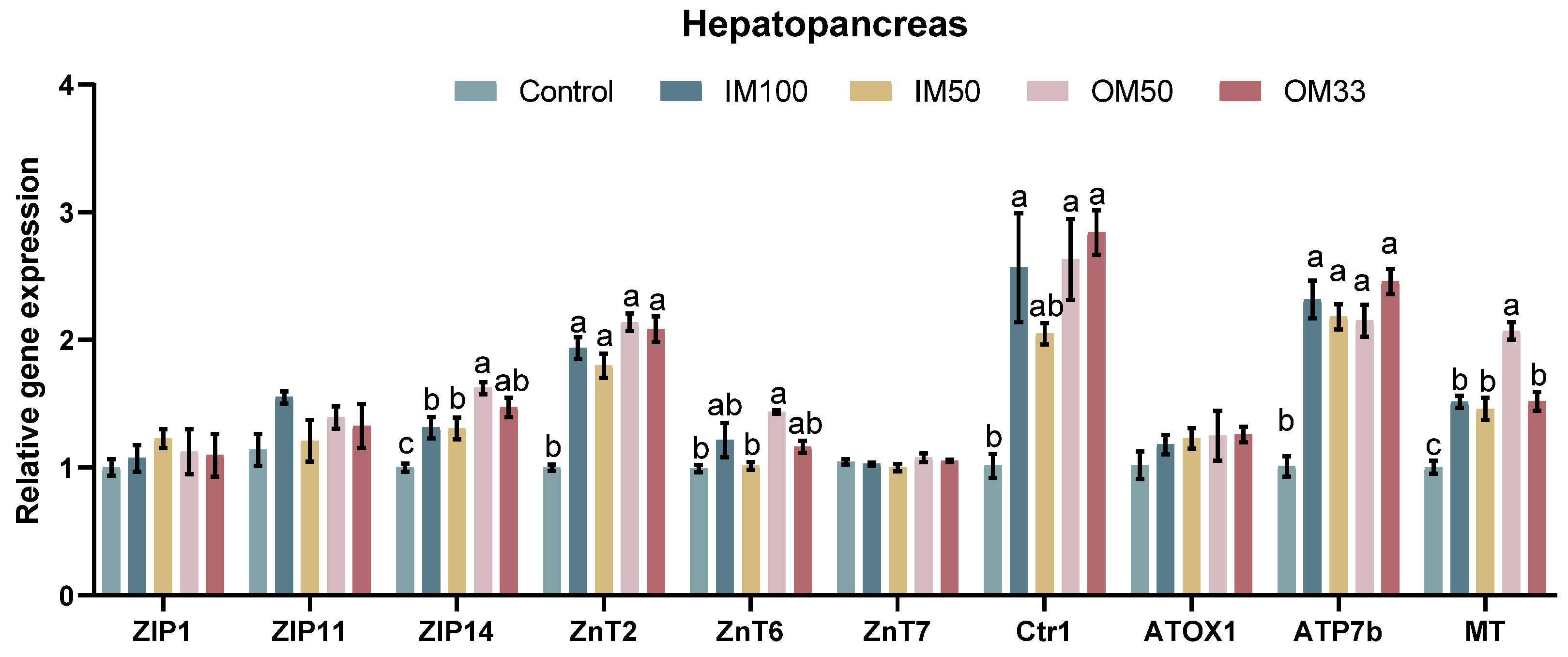
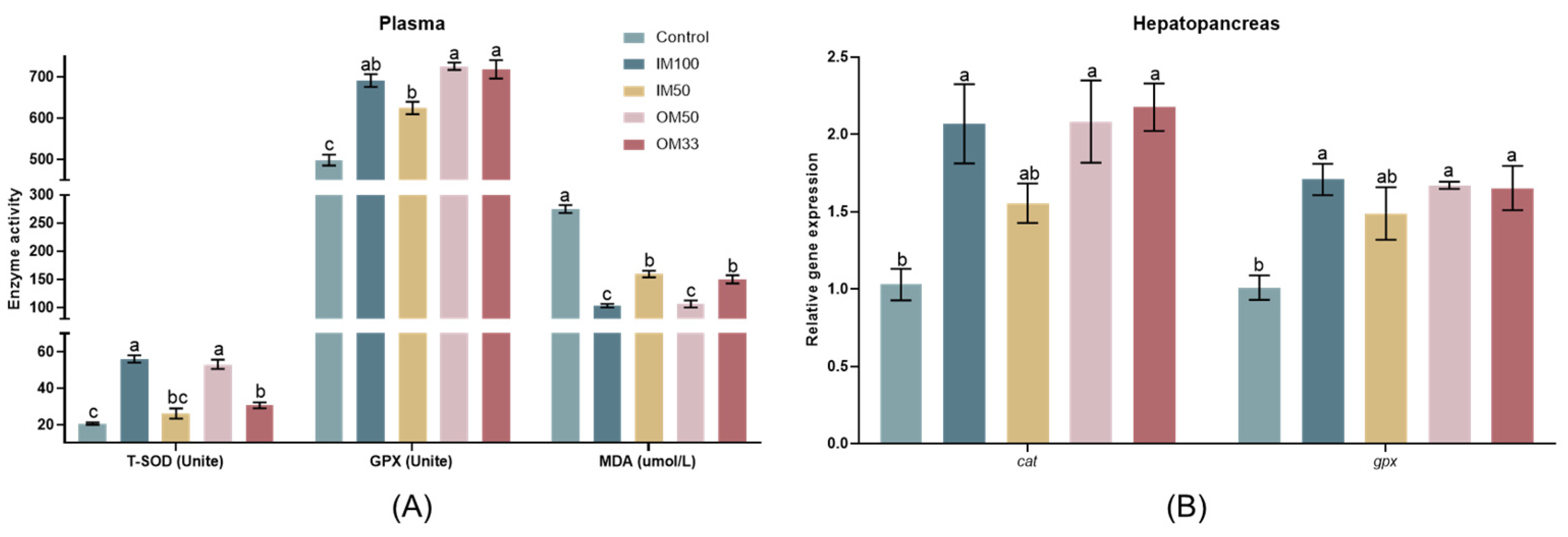

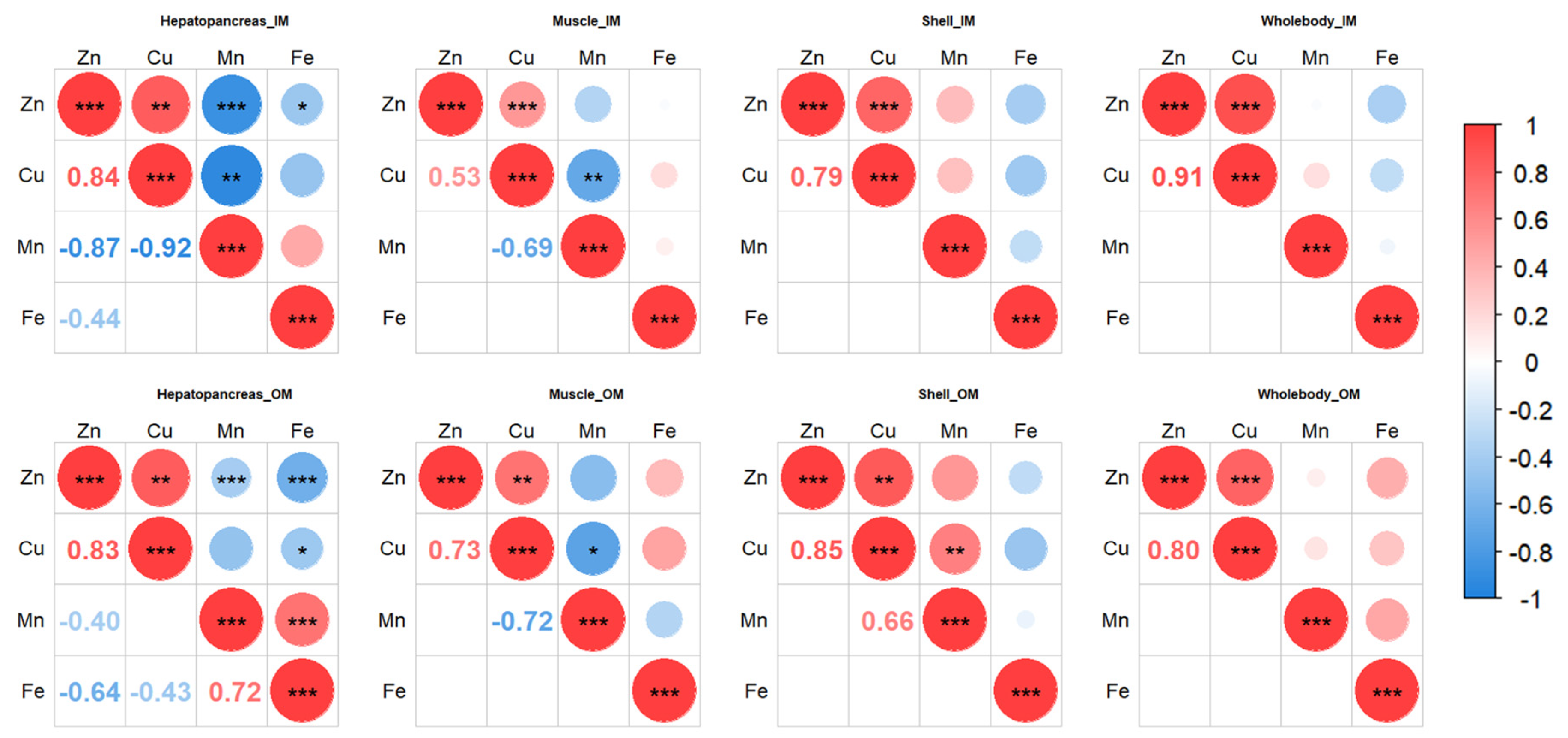
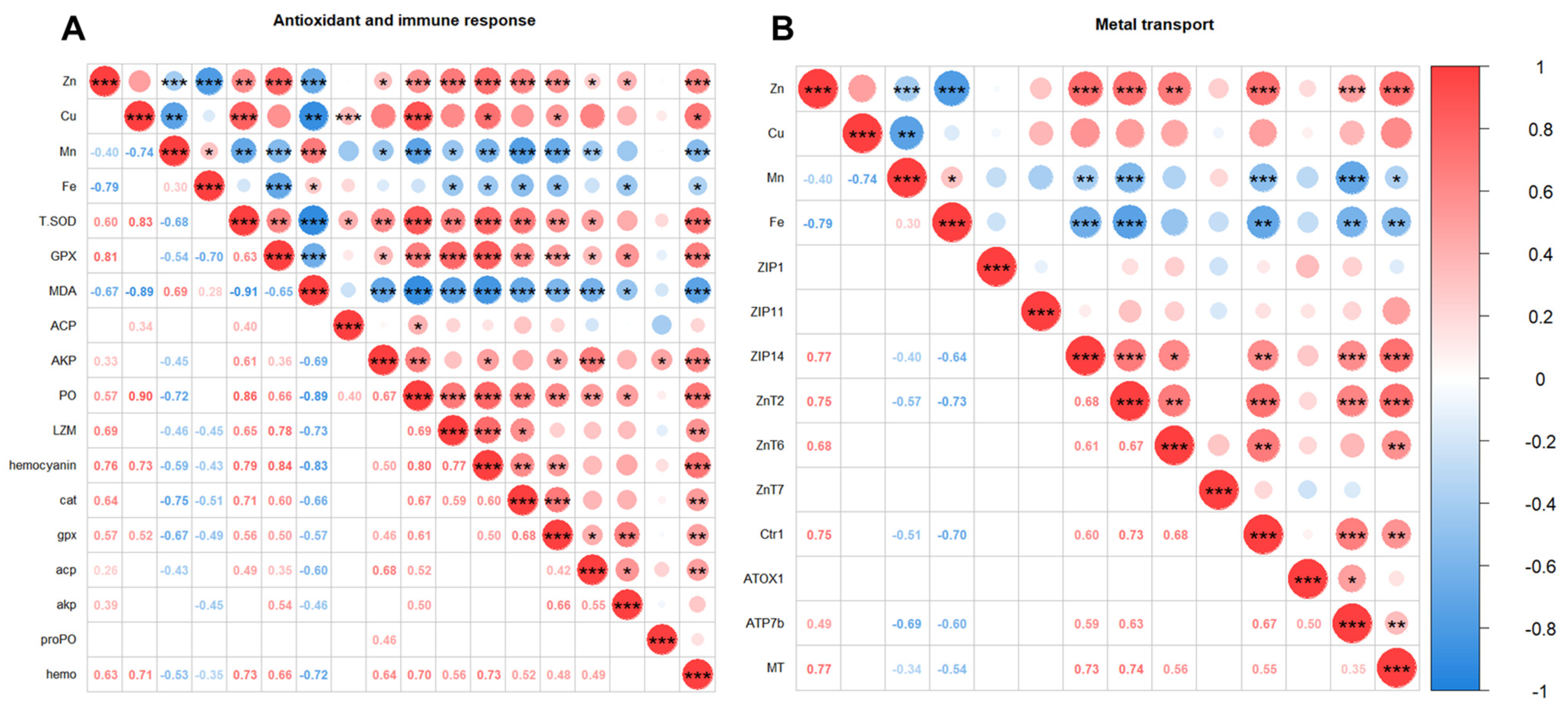
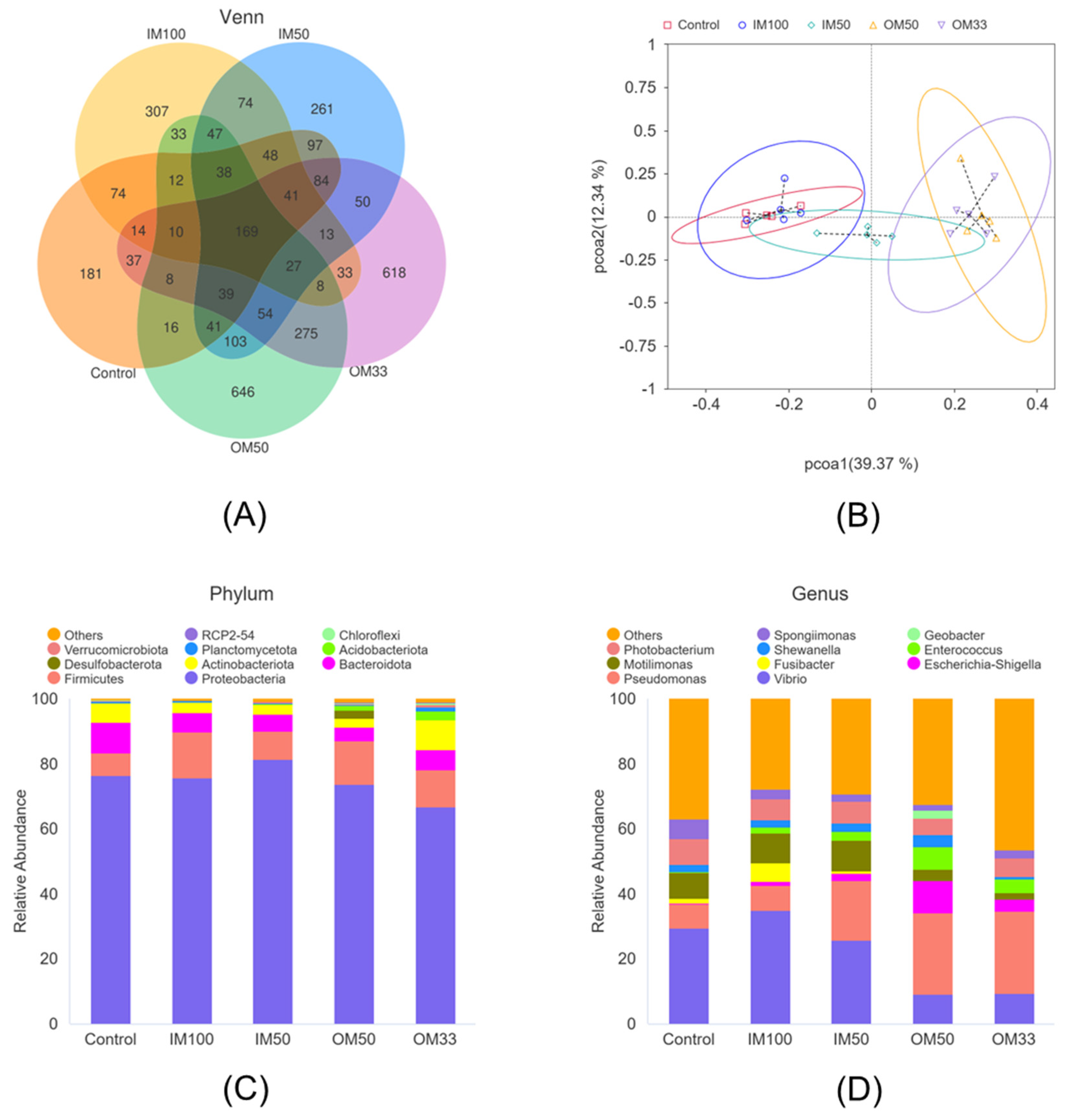
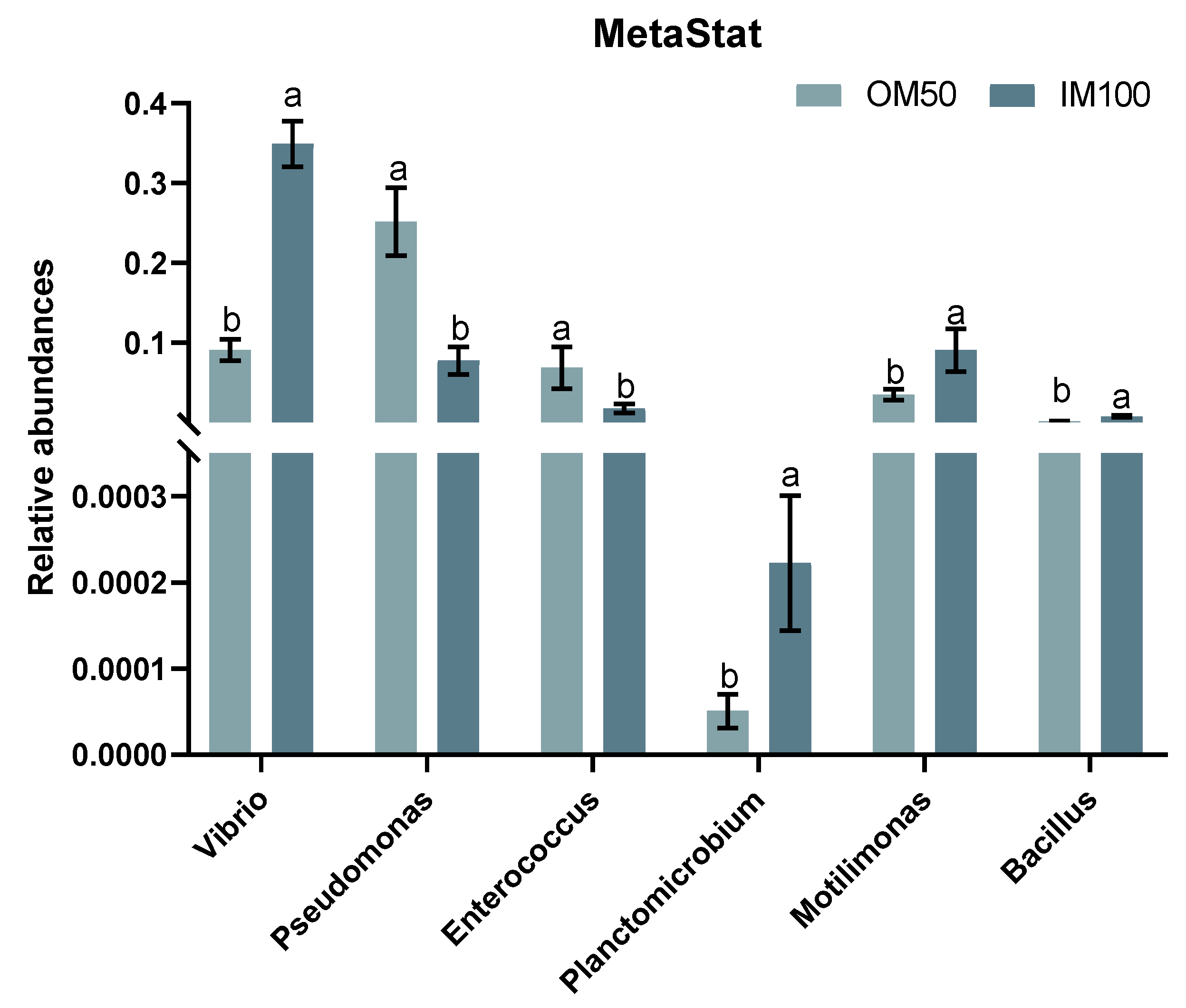
| Ingredients (%) | Groups | ||||
|---|---|---|---|---|---|
| Control | IM100 | IM50 | OM50 | OM33 | |
| Flour | 24.19 | 24.19 | 24.19 | 24.19 | 24.19 |
| Soybean meal | 24.00 | 24.00 | 24.00 | 24.00 | 24.00 |
| Peanut meal | 15.00 | 15.00 | 15.00 | 15.00 | 15.00 |
| Dephenolized cottonseed protein | 14.00 | 14.00 | 14.00 | 14.00 | 14.00 |
| Fish meal | 7.00 | 7.00 | 7.00 | 7.00 | 7.00 |
| Shrimp meal | 1.00 | 1.00 | 1.00 | 1.00 | 1.00 |
| gluten | 4.00 | 4.00 | 4.00 | 4.00 | 4.00 |
| Chicken meal | 3.00 | 3.00 | 3.00 | 3.00 | 3.00 |
| Fish oil | 4.00 | 4.00 | 4.00 | 4.00 | 4.00 |
| Phospholipid | 2.00 | 2.00 | 2.00 | 2.00 | 2.00 |
| Crystal methionine | 0.30 | 0.30 | 0.30 | 0.30 | 0.30 |
| Monocalcium phosphate | 1.00 | 1.00 | 1.00 | 1.00 | 1.00 |
| Choline chloride 1 | 0.20 | 0.20 | 0.20 | 0.20 | 0.20 |
| Y2O3 1 | 0.01 | 0.01 | 0.01 | 0.01 | 0.01 |
| Vitamin mix 2 | 0.10 | 0.10 | 0.10 | 0.10 | 0.10 |
| Mineral mix 3 | 0.20 | 0.20 | 0.20 | 0.20 | 0.20 |
| Analyzed Nutrient Compositions (% Dry Matter) | |||||
| Moisture | 5.21 | 5.92 | 6.79 | 6.49 | 5.28 |
| Crude protein | 47.13 | 47.11 | 46.82 | 46.98 | 46.19 |
| Crude lipid | 4.93 | 5.06 | 4.27 | 4.77 | 4.58 |
| Ash | 8.00 | 7.07 | 6.15 | 6.78 | 6.74 |
| Analyzed Trace Minerals Contents (mg/kg; Dry Matter) | |||||
| Zn | 45.04 | 155.17 | 95.45 | 98.38 | 79.37 |
| Cu | 5.56 | 29.05 | 15.03 | 17.08 | 13.15 |
| Mn | 37.36 | 55.12 | 43.73 | 51.26 | 39.23 |
| Fe | 209.57 | 236.08 | 176.13 | 181.17 | 171.78 |
| Diets | Control | IM100 | IM50 | OM50 | OM33 |
|---|---|---|---|---|---|
| IBW (g) | 7.19 ± 0.08 | 7.21 ± 0.01 | 7.22 ± 0.07 | 7.27 ± 0.07 | 7.17 ± 0.05 |
| FBW (g) | 14.75 ± 0.26 | 15.45 ± 0.21 | 14.91 ± 0.24 | 15.41 ± 0.26 | 14.41 ± 0.26 |
| WGR (%) | 107.83 ± 2.58 | 114.46 ± 3.12 | 106.77 ± 4.12 | 112.21 ± 5.39 | 101.18 ± 4.38 |
| SGR (%/day) | 1.31 ± 0.0221 | 1.36 ± 0.0259 | 1.30 ± 0.0358 | 1.34 ± 0.0452 | 1.25 ± 0.0385 |
| CF (100 g/cm3) | 1.94 ± 0.0052 | 1.92 ± 0.0255 | 1.92 ± 0.0049 | 1.94 ± 0.0114 | 1.91 ± 0.0089 |
| FI (%/day) | 2.44 ± 0.0317 | 2.41 ± 0.0234 | 2.40 ± 0.0284 | 2.41 ± 0.0212 | 2.44 ± 0.0263 |
| FE | 0.49 ± 0.0304 | 0.54 ± 0.0145 | 0.52 ± 0.0175 | 0.53 ± 0.0207 | 0.49 ± 0.0175 |
| Survival (%) | 86.25 ± 5.45 | 81.88 ± 1.57 | 85.00 ± 2.04 | 81.25 ± 1.61 | 86.25 ± 2.60 |
| Diets | Control | IM100 | IM50 | OM50 | OM33 |
|---|---|---|---|---|---|
| T-CHO (mmol/L) | 17.26 ± 0.58 a | 9.05 ± 0.41 c | 14.75 ± 1.13 ab | 12.27 ± 0.46 b | 13.94 ± 0.88 b |
| TG (mmol/L) | 3.53 ± 0.10 a | 1.19 ± 0.07 c | 2.40 ± 0.10 b | 1.36 ± 0.11 c | 1.53 ± 0.10 c |
| GLU (mg/dL) | 31.86 ± 1.83 | 32.90 ± 1.93 | 31.81 ± 1.11 | 32.24 ± 1.15 | 32.67 ± 0.70 |
| TP (g/L) | 39.32 ± 1.38 c | 59.13 ± 1.46 a | 49.31 ± 1.77 b | 64.31 ± 2.69 a | 44.20 ± 1.76 bc |
| ALB (g/L) | 23.06 ± 0.88 ab | 27.80 ± 1.96 a | 25.82 ± 2.51 ab | 27.84 ± 2.05 a | 18.22 ± 1.75 b |
| Diets | Control | IM100 | IM50 | OM50 | OM33 |
|---|---|---|---|---|---|
| Zn | 25.91 ± 2.33 a | 11.68 ± 1.17 b | 20.98 ± 1.33 a | 22.36 ± 2.50 a | 18.92 ± 0.51 ab |
| Cu | 82.29 ± 1.70 b | 85.90 ± 0.77 ab | 89.59 ± 0.94 a | 89.40 ± 0.90 a | 87.79 ± 0.50 a |
| Mn | −748 ± 173 | −422 ± 168 | −869 ± 195 | −390 ± 103 | −506 ± 178 |
| Fe | −165 ± 75 | −73 ± 16 | −306 ± 120 | −178 ± 73 | −75 ± 7 |
Disclaimer/Publisher’s Note: The statements, opinions and data contained in all publications are solely those of the individual author(s) and contributor(s) and not of MDPI and/or the editor(s). MDPI and/or the editor(s) disclaim responsibility for any injury to people or property resulting from any ideas, methods, instructions or products referred to in the content. |
© 2025 by the authors. Licensee MDPI, Basel, Switzerland. This article is an open access article distributed under the terms and conditions of the Creative Commons Attribution (CC BY) license (https://creativecommons.org/licenses/by/4.0/).
Share and Cite
Huang, W.; Yang, J.; Li, X.; Lin, G.; Li, M.; Zhang, Y.; Mai, K. Organic Trace Mineral Source Enhances the Bioavailability, Health Status, and Gut Microbiota Community in White Shrimp (Penaeus vannamei). Biology 2025, 14, 540. https://doi.org/10.3390/biology14050540
Huang W, Yang J, Li X, Lin G, Li M, Zhang Y, Mai K. Organic Trace Mineral Source Enhances the Bioavailability, Health Status, and Gut Microbiota Community in White Shrimp (Penaeus vannamei). Biology. 2025; 14(5):540. https://doi.org/10.3390/biology14050540
Chicago/Turabian StyleHuang, Weijian, Jinzhu Yang, Xiao Li, Gang Lin, Mingzhu Li, Yanjiao Zhang, and Kangsen Mai. 2025. "Organic Trace Mineral Source Enhances the Bioavailability, Health Status, and Gut Microbiota Community in White Shrimp (Penaeus vannamei)" Biology 14, no. 5: 540. https://doi.org/10.3390/biology14050540
APA StyleHuang, W., Yang, J., Li, X., Lin, G., Li, M., Zhang, Y., & Mai, K. (2025). Organic Trace Mineral Source Enhances the Bioavailability, Health Status, and Gut Microbiota Community in White Shrimp (Penaeus vannamei). Biology, 14(5), 540. https://doi.org/10.3390/biology14050540







